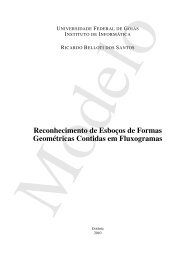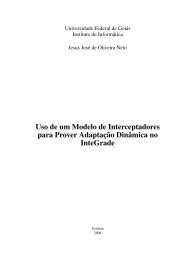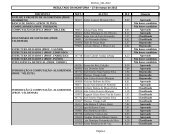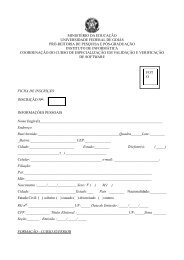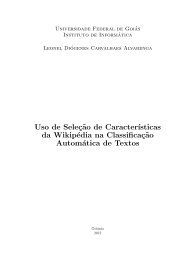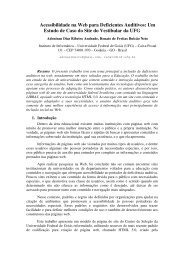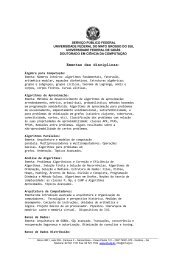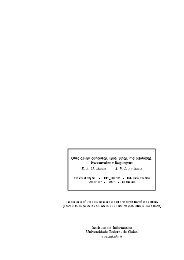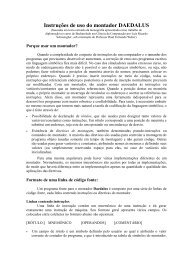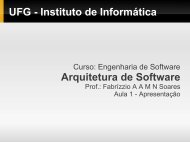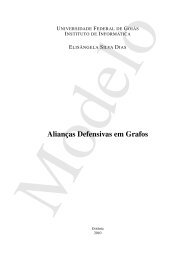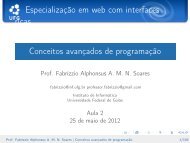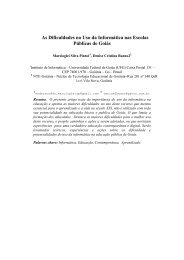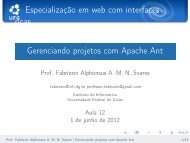- Page 2:
Evolutionary Computation
- Page 5 and 6:
c○ 2006 Massachusetts Institute o
- Page 7 and 8:
vi CONTENTS 4 A Unified View of Sim
- Page 9 and 10:
viii CONTENTS 6.5.7 Selection, Repr
- Page 12 and 13:
Chapter 1 Introduction The field of
- Page 14 and 15:
1.2. EV: A SIMPLE EVOLUTIONARY SYST
- Page 16 and 17:
1.2. EV: A SIMPLE EVOLUTIONARY SYST
- Page 18 and 19:
1.3. EV ON A SIMPLE FITNESS LANDSCA
- Page 20 and 21:
1.3. EV ON A SIMPLE FITNESS LANDSCA
- Page 22 and 23:
1.3. EV ON A SIMPLE FITNESS LANDSCA
- Page 24 and 25:
1.3. EV ON A SIMPLE FITNESS LANDSCA
- Page 26 and 27:
1.4. EV ON A MORE COMPLEX FITNESS L
- Page 28 and 29:
1.4. EV ON A MORE COMPLEX FITNESS L
- Page 30 and 31:
1.5. EVOLUTIONARY SYSTEMS AS PROBLE
- Page 32:
1.6. EXERCISES 21 1.6 Exercises 1.
- Page 35 and 36:
24 CHAPTER 2. A HISTORICAL PERSPECT
- Page 37 and 38:
26 CHAPTER 2. A HISTORICAL PERSPECT
- Page 39 and 40:
28 CHAPTER 2. A HISTORICAL PERSPECT
- Page 41 and 42:
30 CHAPTER 2. A HISTORICAL PERSPECT
- Page 44 and 45:
Chapter 3 Canonical Evolutionary Al
- Page 46 and 47:
3.3. EVOLUTIONARY PROGRAMMING 35 55
- Page 48 and 49:
3.4. EVOLUTION STRATEGIES 37 55 50
- Page 50 and 51:
3.4. EVOLUTION STRATEGIES 39 55 50
- Page 52 and 53:
3.5. GENETIC ALGORITHMS 41 Define s
- Page 54 and 55:
3.5. GENETIC ALGORITHMS 43 3.5.2 Un
- Page 56 and 57:
3.5. GENETIC ALGORITHMS 45 Populati
- Page 58:
3.6. SUMMARY 47 3.6 Summary The can
- Page 61 and 62:
50 CHAPTER 4. A UNIFIED VIEW OF SIM
- Page 63 and 64:
52 CHAPTER 4. A UNIFIED VIEW OF SIM
- Page 65 and 66:
54 CHAPTER 4. A UNIFIED VIEW OF SIM
- Page 67 and 68:
56 CHAPTER 4. A UNIFIED VIEW OF SIM
- Page 69 and 70:
58 CHAPTER 4. A UNIFIED VIEW OF SIM
- Page 71 and 72:
60 CHAPTER 4. A UNIFIED VIEW OF SIM
- Page 73 and 74:
62 CHAPTER 4. A UNIFIED VIEW OF SIM
- Page 75 and 76:
64 CHAPTER 4. A UNIFIED VIEW OF SIM
- Page 77 and 78:
66 CHAPTER 4. A UNIFIED VIEW OF SIM
- Page 79 and 80:
68 CHAPTER 4. A UNIFIED VIEW OF SIM
- Page 82 and 83:
Chapter 5 Evolutionary Algorithms a
- Page 84 and 85:
5.1. SIMPLE EAS AS PARALLEL ADAPTIV
- Page 86 and 87:
5.1. SIMPLE EAS AS PARALLEL ADAPTIV
- Page 88 and 89:
5.1. SIMPLE EAS AS PARALLEL ADAPTIV
- Page 90 and 91:
5.1. SIMPLE EAS AS PARALLEL ADAPTIV
- Page 92 and 93:
5.2. EA-BASED OPTIMIZATION 81 them
- Page 94 and 95:
5.2. EA-BASED OPTIMIZATION 83 of th
- Page 96 and 97:
5.2. EA-BASED OPTIMIZATION 85 one o
- Page 98 and 99:
5.2. EA-BASED OPTIMIZATION 87 60 40
- Page 100 and 101:
5.2. EA-BASED OPTIMIZATION 89 Notic
- Page 102 and 103:
5.2. EA-BASED OPTIMIZATION 91 120 1
- Page 104 and 105:
5.2. EA-BASED OPTIMIZATION 93 parti
- Page 106 and 107:
5.2. EA-BASED OPTIMIZATION 95 5 0 O
- Page 108 and 109:
5.2. EA-BASED OPTIMIZATION 97 5.2.2
- Page 110 and 111:
5.2. EA-BASED OPTIMIZATION 99 of tr
- Page 112 and 113:
5.2. EA-BASED OPTIMIZATION 101 700
- Page 114 and 115:
5.2. EA-BASED OPTIMIZATION 103 5.2.
- Page 116 and 117:
5.3. EA-BASED SEARCH 105 • In the
- Page 118 and 119:
5.4. EA-BASED MACHINE LEARNING 107
- Page 120 and 121:
5.5. EA-BASED AUTOMATED PROGRAMMING
- Page 122 and 123:
5.5. EA-BASED AUTOMATED PROGRAMMING
- Page 124:
5.7. SUMMARY 113 the effect of impr
- Page 127 and 128:
116 CHAPTER 6. EVOLUTIONARY COMPUTA
- Page 129 and 130:
118 CHAPTER 6. EVOLUTIONARY COMPUTA
- Page 131 and 132:
120 CHAPTER 6. EVOLUTIONARY COMPUTA
- Page 133 and 134:
122 CHAPTER 6. EVOLUTIONARY COMPUTA
- Page 135 and 136:
124 CHAPTER 6. EVOLUTIONARY COMPUTA
- Page 137 and 138:
126 CHAPTER 6. EVOLUTIONARY COMPUTA
- Page 139 and 140:
128 CHAPTER 6. EVOLUTIONARY COMPUTA
- Page 141 and 142:
130 CHAPTER 6. EVOLUTIONARY COMPUTA
- Page 143 and 144:
132 CHAPTER 6. EVOLUTIONARY COMPUTA
- Page 145 and 146:
134 CHAPTER 6. EVOLUTIONARY COMPUTA
- Page 147 and 148:
136 CHAPTER 6. EVOLUTIONARY COMPUTA
- Page 149 and 150:
138 CHAPTER 6. EVOLUTIONARY COMPUTA
- Page 151 and 152:
140 CHAPTER 6. EVOLUTIONARY COMPUTA
- Page 153 and 154:
142 CHAPTER 6. EVOLUTIONARY COMPUTA
- Page 155 and 156:
144 CHAPTER 6. EVOLUTIONARY COMPUTA
- Page 157 and 158:
146 CHAPTER 6. EVOLUTIONARY COMPUTA
- Page 159 and 160:
148 CHAPTER 6. EVOLUTIONARY COMPUTA
- Page 161 and 162:
150 CHAPTER 6. EVOLUTIONARY COMPUTA
- Page 163 and 164:
152 CHAPTER 6. EVOLUTIONARY COMPUTA
- Page 165 and 166:
154 CHAPTER 6. EVOLUTIONARY COMPUTA
- Page 167 and 168:
156 CHAPTER 6. EVOLUTIONARY COMPUTA
- Page 169 and 170:
158 CHAPTER 6. EVOLUTIONARY COMPUTA
- Page 171 and 172:
160 CHAPTER 6. EVOLUTIONARY COMPUTA
- Page 173 and 174:
162 CHAPTER 6. EVOLUTIONARY COMPUTA
- Page 175 and 176:
164 CHAPTER 6. EVOLUTIONARY COMPUTA
- Page 177 and 178: 166 CHAPTER 6. EVOLUTIONARY COMPUTA
- Page 179 and 180: 168 CHAPTER 6. EVOLUTIONARY COMPUTA
- Page 181 and 182: 170 CHAPTER 6. EVOLUTIONARY COMPUTA
- Page 183 and 184: 172 CHAPTER 6. EVOLUTIONARY COMPUTA
- Page 185 and 186: 174 CHAPTER 6. EVOLUTIONARY COMPUTA
- Page 187 and 188: 176 CHAPTER 6. EVOLUTIONARY COMPUTA
- Page 189 and 190: 178 CHAPTER 6. EVOLUTIONARY COMPUTA
- Page 191 and 192: 180 CHAPTER 6. EVOLUTIONARY COMPUTA
- Page 193 and 194: 182 CHAPTER 6. EVOLUTIONARY COMPUTA
- Page 195 and 196: 184 CHAPTER 6. EVOLUTIONARY COMPUTA
- Page 197 and 198: 186 CHAPTER 6. EVOLUTIONARY COMPUTA
- Page 199 and 200: 188 CHAPTER 6. EVOLUTIONARY COMPUTA
- Page 201 and 202: 190 CHAPTER 6. EVOLUTIONARY COMPUTA
- Page 203 and 204: 192 CHAPTER 6. EVOLUTIONARY COMPUTA
- Page 205 and 206: 194 CHAPTER 6. EVOLUTIONARY COMPUTA
- Page 207 and 208: 196 CHAPTER 6. EVOLUTIONARY COMPUTA
- Page 209 and 210: 198 CHAPTER 6. EVOLUTIONARY COMPUTA
- Page 211 and 212: 200 CHAPTER 6. EVOLUTIONARY COMPUTA
- Page 213 and 214: 202 CHAPTER 6. EVOLUTIONARY COMPUTA
- Page 215 and 216: 204 CHAPTER 6. EVOLUTIONARY COMPUTA
- Page 217 and 218: 206 CHAPTER 6. EVOLUTIONARY COMPUTA
- Page 219 and 220: 208 CHAPTER 6. EVOLUTIONARY COMPUTA
- Page 222 and 223: Chapter 7 Advanced EC Topics The pr
- Page 224 and 225: 7.2. DYNAMIC LANDSCAPES 213 nested
- Page 226 and 227: 7.2. DYNAMIC LANDSCAPES 215 10 8 Fi
- Page 230 and 231: 7.3. EXPLOITING PARALLELISM 219 7.2
- Page 232 and 233: 7.4. EVOLVING EXECUTABLE OBJECTS 22
- Page 234 and 235: 7.5. MULTI-OBJECTIVE EAS 223 be of
- Page 236 and 237: 7.7. BIOLOGICALLY INSPIRED EXTENSIO
- Page 238 and 239: 7.7. BIOLOGICALLY INSPIRED EXTENSIO
- Page 240 and 241: 7.7. BIOLOGICALLY INSPIRED EXTENSIO
- Page 242 and 243: Chapter 8 The Road Ahead As a well-
- Page 244 and 245: Appendix A Source Code Overview Rat
- Page 246 and 247: A.1. EC1: A VERY SIMPLE EC SYSTEM 2
- Page 248 and 249: A.3. EC3: A MORE FLEXIBLE EC SYSTEM
- Page 250 and 251: A.3. EC3: A MORE FLEXIBLE EC SYSTEM
- Page 252 and 253: Bibliography Altenberg, L. (1994).
- Page 254 and 255: BIBLIOGRAPHY 243 Collins, R. and D.
- Page 256 and 257: BIBLIOGRAPHY 245 Frank, S. A. (1995
- Page 258 and 259: BIBLIOGRAPHY 247 Jansen, T., K. De
- Page 260 and 261: BIBLIOGRAPHY 249 Potter, M. A., J.
- Page 262 and 263: BIBLIOGRAPHY 251 Spears, W. (2000).
- Page 264 and 265: Index 1-point crossover operator, 2
- Page 266 and 267: INDEX 255 graph structures, 74-76,



